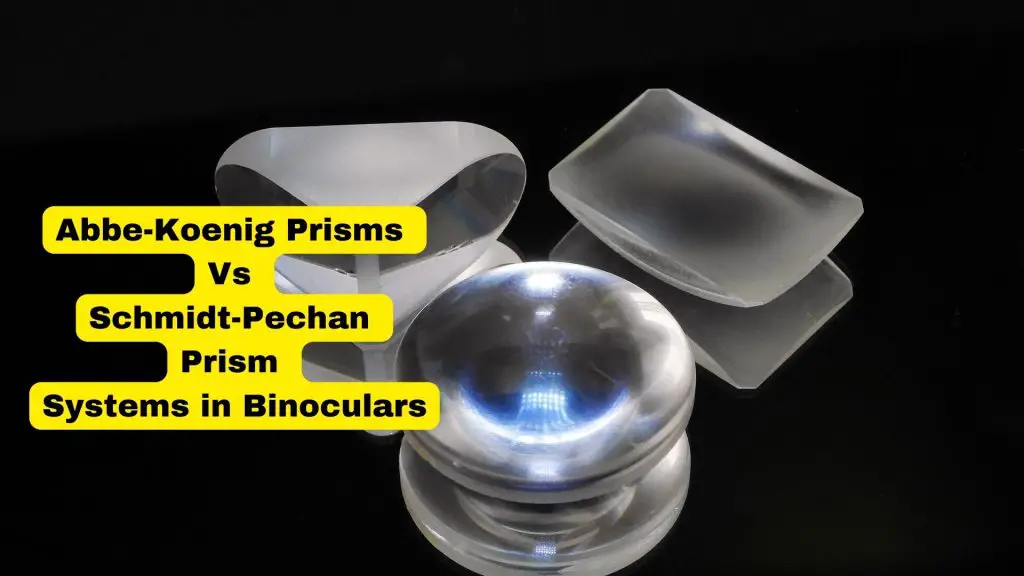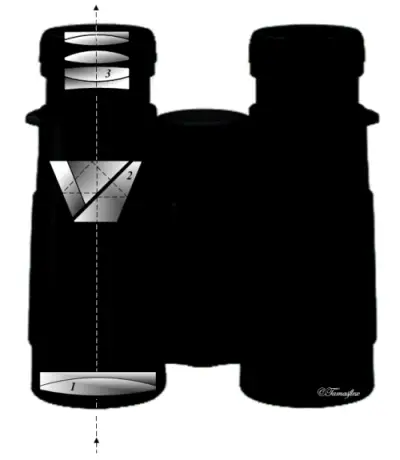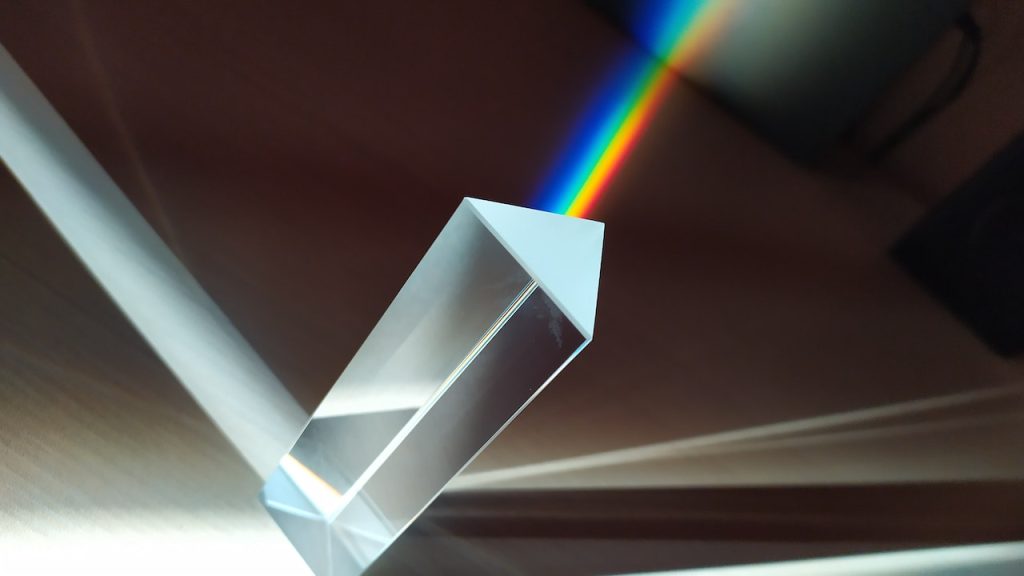Abbe-Koenig Prisms Vs Schmidt-Pechan Prism Systems
If you’re in the market for a new pair of binoculars, you’ve probably heard about two different types of prism systems – Abbe-Koenig prisms and Schmidt-Pechan prism systems. These prism systems play a critical role in determining the optical quality, size, weight, and cost of a pair of binoculars.
But what’s the difference between the two? Which one should you choose? To help you make an informed decision, let’s take a closer look at Abbe-Koenig prisms and Schmidt-Pechan prism systems, and compare their history, design, advantages, disadvantages, and applications.
So, let’s get started!

Abbe-Koenig Prisms
A. History and Development
Abbe-Koenig prisms are named after their inventors, Ernst Abbe and Albert Koenig, who developed them in the late 19th century.
They were designed to be used in optical instruments, particularly in binoculars, to correct the orientation of the image and fold the optical path.
Abbe and Koenig’s design was revolutionary because it reduced the length of the optical tube, making it more compact and portable.
B. Design and Construction
Abbe-Koenig prisms are constructed of two right-angle prisms and a roof prism. The two right-angle prisms are cemented together forming a shallow, symmetrical V-shaped assembly with a thin layer of a transparent adhesive.
Light enters through one face at normal incidence, is internally reflected from a 30-degree sloped face, and then passes through a “roof” section made of two faces meeting at a 90-degree angle at the bottom of the prism. The light is then reflected from the opposite 30-degree face and exits the prism again at normal incidence.
Through the four internal reflections (with two reflections occurring on roof planes), the image is flipped both vertically and horizontally. Since the light is reflected an even number of times, this produces a 180-degree image rotation without changing the image’s handedness, allowing the prism to be used as an image erecting system.
C. Advantages and Disadvantages
One of the main advantages of Abbe-Koenig prisms is that they are more compact than other prism systems, such as the Porro and Schmidt-Pechan prisms.
This makes them ideal for use in portable optical instruments like binoculars. Another advantage is that they have a higher optical efficiency, which means that they produce brighter and sharper images.
Also, Unlike the more common double Porro prism configuration, the Abbe-Koenig prism does not displace the output beam from the input beam, giving it an advantage in some instruments.
However, Abbe-Koenig prisms are more expensive to produce than other prism systems, which can make them less accessible to budget-conscious consumers. They are also more challenging to align and assemble, making them harder to manufacture.
D. Applications and Use Cases
Abbe-Koenig prisms are most commonly used in binoculars and other optical instruments, where their compact size and high optical efficiency make them ideal. They are also used in scientific instruments, such as spectrometers, and in cameras to correct image orientation.
One example of the use of Abbe-Koenig prisms is in military-grade binoculars, which require high optical performance, portability, and durability. The Abbe-Koenig prism system is the ideal choice for these requirements, and it has been used in military binoculars for many years.

Schmidt-Pechan Prism Systems: Image Credit: Wikimedia
Schmidt-Pechan Prism Systems
A Schmidt-Pechan prism system is a type of optical prism system used in binoculars, telescopes, and other optical devices.
It is similar to the Abbe-Koenig prism system in that it is a type of roof prism system that allows for compact and lightweight design. However, there are several differences between the two, including the design and construction of the prism system.
A. History and Development
The Schmidt-Pechan prism system was developed in the mid-20th century by a German optical engineer named Bernhard Schmidt.
It was later improved upon by Karl Pechan, another German optical engineer. The Schmidt-Pechan prism system was designed as an alternative to the Abbe-Koenig prism system, which was widely used at the time.
B. Design and Construction
The Schmidt-Pechan prism is made up of two prisms separated by an air gap and is designed to both invert and revert the image, acting as an image rotator.
The upper prism is a Schmidt roof prism, while the lower prism is a half-pentaprism or Bauernfeind prism.
The entrance and exit beams are coaxial, and the prism does not deviate the beam if it is centered on the optical axis.
The “roof” section of the upper prism flips the image laterally with two total internal reflections in the horizontal plane. The lower prism corrects for this by interfacing the beam at 45° with the upper prism. The net effect of the six reflections is to flip the image both vertically and horizontally.
C. Advantages and Disadvantages
One advantage of the Schmidt-Pechan prism system is its compact and lightweight design. This makes it a popular choice for binoculars and other portable optical devices. It also provides a wider field of view compared to the Abbe-Koenig prism system, which can be beneficial in certain applications.
However, one disadvantage of the Schmidt-Pechan prism system is that it can produce a slight distortion in the image, particularly at the edges of the field of view. It also requires more precise alignment of the prism elements to ensure optimal optical performance.
D. Applications and Use Cases
The Schmidt-Pechan prism system is widely used in binoculars, telescopes, and other optical devices.
Its compact and lightweight design make it a popular choice for portable devices, such as binoculars for outdoor activities like hiking and birdwatching. Its wider field of view is also beneficial for astronomy and other applications where a wider field of view is desired.

Comparison of Abbe-Koenig Prisms and Schmidt-Pechan Prism Systems
Two common prism systems used in binoculars are the Abbe-Koenig prisms and the Schmidt-Pechan prism system as we saw above.
Here we’ll take a closer look at the differences between these two prism systems in terms of optical performance, size and weight, cost, and availability, as well as their pros and cons.
A. Optical performance:
The Abbe-Koenig prisms are known for their excellent light-gathering ability.
So, the Abbe-Koenig prism system produces a brighter image with better contrast and color accuracy than the Schmidt-Pechan prism system.
Also, Compared to the Abbe-König prism design, the Schmidt-Pechan design reflects light more times and with less efficiency.
Another advantage with The Abbe-Koenig prism system is that this design also eliminates the problem of polarization, which can be a problem with Schmidt-Pechan prism systems.
On the other hand, the Schmidt-Pechan prism system is known for its high-light transmission, making it suitable for low-light conditions.
This prism system is also less prone to internal reflection and produces a compact design that allows for a more streamlined binocular body.
B. Size and weight:
Abbe-Koenig prisms are not as commonly used as Schmidt-Pechan prisms. They are significantly longer and heavier than Schmidt-Pechan prisms, which makes them less desirable for applications where size and weight are important factors
The Schmidt-Pechan prism system, on the other hand, produces a more compact and lightweight design, making it ideal for outdoor activities.
Note : Abbe-Koenig prisms still used in large roof prism binoculars where light-gathering power is more important than compactness and cost.
C. Cost and availability:
The cost of Abbe-Koenig prism systems tends to be higher than that of Schmidt-Pechan prism systems. This is due to the higher level of precision required in the manufacturing process of Abbe-Koenig prisms.
Schmidt-Pechan prism systems are also more widely available than Abbe-Koenig prism systems.
D. Pros and cons:
In summary, the Abbe-Koenig prism system offers excellent optical performance, better contrast and color accuracy, and eliminates polarization problems. However, it tends to be larger, heavier, and more expensive than the Schmidt-Pechan prism system.
The Schmidt-Pechan prism system, on the other hand, offers high light transmission, a more compact and lightweight design, and is generally more affordable and widely available. However, it is more prone to internal reflection and does not offer the same level of color accuracy and contrast as the Abbe-Koenig prism system.
How to Identify Abbe-Koenig Prisms or Schmidt-Pechan Prism Systems in Binoculars Without Opening Them
Unfortunately, there is no way to determine the type of prism system inside binoculars without opening them up and inspecting the internal components.
The prism system is a critical part of the binoculars, and it is designed to bend and reflect light in specific ways, depending on the type of prism system used.
The only way to determine the type of prism system inside binoculars is to refer to the product specifications provided by the manufacturer or seller. They will usually indicate whether the binoculars use Abbe-Koenig prisms or Schmidt-Pechan prism systems in their description or product details.
Alternatively, you can contact the manufacturer or seller directly to ask about the type of prism system used in the binoculars you are interested in.
Comparison of Abbe-Koenig Prisms and Schmidt-Pechan Prism Systems:
| Criteria | Abbe-Koenig Prisms | Schmidt-Pechan Prism System |
|---|---|---|
| Optical performance | Excellent light-gathering ability, produces a brighter image with better contrast and color accuracy | High-light transmission suitable for low-light conditions, less prone to internal reflection, produces a more compact design |
| Size and weight | Larger and heavier, suitable for large roof prism binoculars | More compact and lightweight, ideal for outdoor activities |
| Cost and availability | More expensive due to higher precision required in manufacturing | Generally more affordable and widely available |
| Pros | Excellent optical performance, eliminates polarization problems | High light transmission, more compact and lightweight, affordable and widely available |
| Cons | Larger, heavier, and more expensive | More prone to internal reflection, does not offer the same level of color accuracy and contrast as Abbe-Koenig prism system |
Some popular models of binoculars that use Abbe-Koenig prisms Schmidt-Pechan prism systems:
Schmidt-Pechan Prism Systems:
- Zeiss Terra ED 8×42 Binoculars
- Swarovski SLC 8×42 Binoculars
- Sig Sauer ZULU6 16x42mm
- Gpo Passion Ed Binoculars
Abbe-Koenig Prisms:
- SIG-Sauer Zulu 9 (9×45 / 11×45)
- Swarovski SLC 8×56 / 10×56 / 15×56
- Zeiss Conquest 8×50 / 10×50 / 8×56
Zeiss Conquest HD 8×56 / 10×56 / 15×56
Zeiss Victory HT 8×54 / 10×54
- Swarovski SLC 8×56 / 10×56 / 15×56
An Interesting Video-Abbe-Koenig Prisms Vs Schmidt-Pechan Prism Systems
Conclusion
In conclusion, both Abbe-Koenig prisms and Schmidt-Pechan prism systems are widely used in modern binoculars and have their own unique advantages and disadvantages.
Abbe-Koenig prisms offer superior image quality, but are typically larger and more expensive. On the other hand, Schmidt-Pechan prism systems are more compact and affordable, but may sacrifice some image quality.
Ultimately, the choice between these prism systems will depend on the specific needs and preferences of the user.
Check: What Is The Binoculars Lens Coating For?
Regardless of which prism system is chosen, binoculars remain an invaluable tool for observing the world around us, whether for bird watching, outdoor recreation, or professional applications.
Resources:
